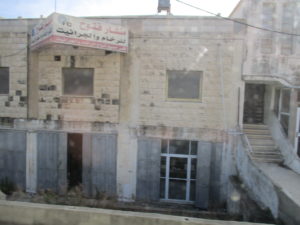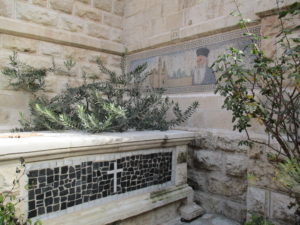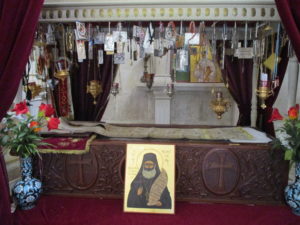Aug 30 | “Just in case,” (Sermon, August 30th 2020)
From that time on, Jesus began to show his disciples that he must go to Jerusalem and undergo great suffering at the hands of the elders and chief priests and scribes, and be killed, and on the third day be raised. 22And Peter took him aside and began to rebuke him, saying, ‘God forbid it, Lord! This must never happen to you.’ 23But he turned and said to Peter, ‘Get behind me, Satan! You are a stumbling-block to me; for you are setting your mind not on divine things but on human things.’
Matthew 16:21-28
24 Then Jesus told his disciples, ‘If any want to become my followers, let them deny themselves and take up their cross and follow me. 25For those who want to save their life will lose it, and those who lose their life for my sake will find it. 26For what will it profit them if they gain the whole world but forfeit their life? Or what will they give in return for their life?
27 ‘For the Son of Man is to come with his angels in the glory of his Father, and then he will repay everyone for what has been done. 28Truly I tell you, there are some standing here who will not taste death before they see the Son of Man coming in his kingdom.’
In last week’s sermon, I opened by talking about my 2017 journey to the Holy Land, and my trip to the region once known as Caesarea Philippi, where last week’s Gospel passage took place.
I said it was a deceptively peaceful place, with soft pleasant hills holding hidden mines – a place where Jesus asked his disciples, “Who do you say that I am?†and Peter actually gets it right for once and says, “You are the Messiah.â€
This week, though, Peter proves that he can only hang onto a world-shattering truth for a minute before it slips through his fingers, or maybe he never really understood in the first place.
So I’ll invite you to leave the gentle slopes of Caesarea Philippi, and come with me to the town of Nablus, another place I visited.
Nablus is a town in the West Bank, nestled in the embrace of Mount Gerizim and Mount Ebal in traditional Samaritan territory. Tourists do not go there. It’s only accessible through a permanent checkpoint, which is sometimes shut down if government officials think the citizens are getting too uppity. Trash and hundreds of broken-down cars in varying states of decay litter the roadways. The buildings are old and dilapidated, and many of them are eerily unfinished. During the optimistic days after the Oslo Accords, people thought peace would come, and Nablus would become a bustling, modern city. They began to build tall towers, hoping to fill them with happy citizens and workers.

But peace never came. Money ran out, and thousands of Palestinian refugees, pushed off their land by the military and settlers, were crammed into camps in the city, putting a huge strain on resources.
We were there to see the Greek Orthodox Church which harbours the ancient Jacob’s Well, the site where Jesus was said to have met the Samaritan woman in the Gospel of John. Although in the story she is unnamed, the Orthodox Church has given her the name Photine, a name related to the Greek word for light. The Gospel story does not follow Photine after her encounter with Jesus at the well, but tradition picked up from there, as it does. There are stories that she converted many people to Christianity before being dragged in front of the Emperor Nero to be tortured and killed as a martyr.
We got off the bus and stood outside the gates of the church, which is housed in a compound owned by a monastery. As we passed through the gates, I reached up and traced a couple of bullet holes with my fingers.
We entered a beautiful garden. A large above-ground tomb was on my right, with a simple black and white mosaic tile pattern framing a cross. It rested snug against the outer wall of the building, and a mural, featuring an elderly Orthodox priest, was painted just above it.

I turned to Greg, the dean of the college. “Who’s buried there?â€
“Oh, it’s empty,†he said.
I looked at him.
He explained. “Well, the priest here, Father Ioustinos, has survived many attempts on his life. There’s been a lot of violence. In fact his predecessor was murdered by a madman who threw a grenade into the building and then hacked him to death with an axe when he ran out. Father Ioustinos decided he might as well build his tomb ahead of time, just in case.â€
Just in case.
Those words are always a bit haunted, aren’t they?
The well was below the main sanctuary, in a little chapel. I touched the water, and was told I could actually drink from it if I wanted. It had a muted, clean taste.
I met Father Ioustinos, a compelling and gentle soul. He was short and slight and taciturn, and sold us icons and rosaries from a little shop set up just to the right of the well. Many of the icons he had written himself. His eyes twinkled as he smiled behind his big beard.
While working on this sermon, I found an interview he did with Vice a year after I returned from the Holy Land. He talks about growing up on Ikaria, a small island off the coast of Greece, and how his family home was occupied by German and Italian Axis forces in World War II. When he decided to become a priest, he said his family stopped talking to him for six years. He doesn’t say why.
He came to Palestine when he was about 21, working in several parishes and hoping to serve as the guardian of Jacob’s Well, but when his predecessor, Philoumenos, was murdered, the church was locked up and the keys taken to Jerusalem. Father Ioustinos said, “I did not want to be the guardian as I was afraid the same thing would happen to me that happened to my friend Philoumenos. One night I had a dream and in the dream I saw a vision of myself repairing the church and serving as the guardian for many years. I went to Jerusalem, got the keys, and soon began picking up the pieces.â€
In 1982, three years after Philoumenos was killed, the murderer, a Jewish convert named Asher Raby, returned. He attacked a nun and Father Ioustinos with his axe, and threw another grenade, but the priest fought him off and Raby was finally arrested. After that, Father Ioustinos recruited boys from one of the nearby refugee camps, trained them as stonemasons, and together they rebuilt. He spent a lot of time painting murals and icons, making the church beautiful again.
Things were relatively peaceful until the Second Intifada in 2000. Father Ioustinos said, “We were suffering very badly. I could not leave these grounds for many months. During this time, I spent most of my days painting murals and praying. I prayed to God and to Philoumenos’s spirit to help protect the church. An Israeli tank fired at our gate but it did not break. They dropped five bombs on the grounds but none of them went off. I am thankful that we were under supervision of the saints.â€
About his tomb, Father Ioustinos says, “Should it be my time to die, I am ready.â€
We went into the church. In a corner, a huge icon of (now) St. Philoumenos, the priest who was murdered, was hung above his tomb.

I stood there for a long time, asking for his strength.
A week or two later, I left the Holy Land and continued with my peaceful and privileged life. I went back to my home in Sen̓áḵw, which was stolen from the Squamish people years before I was born and renamed Kitsilano. I ate food that others had grown and wore clothes that others had sewn. I drank water that didn’t have to be boiled. I went to church, where I never had to worry about finding hateful graffiti or desecrations on the front stoop, or angry men interrupting worship with axes, or Bible study with AR-15s.
Then, in August of that year, I watched Charlottesville, a college town in Virginia, explode in a paroxysm of hate.
As I pored through the photographs, I came upon a series of shots of clergy. Most of them were fully vested, like I am now, or wearing clericals and stoles. Arms linked, they marched through the streets, all genders, all colours, all creeds. Rabbis, imams, priests, pastors.
On several occasions, they were rushed by white supremacists and neo-Nazis as police looked on. Some ended up battered and bloodied, but they stood firm.
I looked at those pictures, and I thought of Philoumenos and the axe.
I thought of Ioustinos and the tank.
I thought of Photine, standing before Nero: calm, resolute.
I thought of Peter, years after his rebuke of Jesus, asking to be crucified upside down because he didn’t dare equate himself to his friend, his Teacher.
I thought of all these reflections of the One who came to us as a servant, a worker, a fellow sufferer, a lynching victim.
And I prayed for their strength.
I still do.
Today, we need it more than ever.
Thanks very much will keep working and praying for the peace
Thank you, Bishara, so many blessings to you.